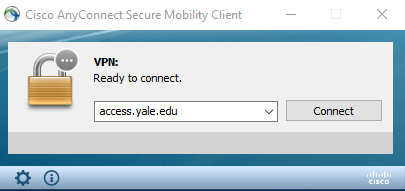YaleSecure (WiFi Wireless)
For Yale Students, Staff and Faculty, YaleSecure is the recommended, encrypted WiFi network. YaleSecure uses your NetID and password to authenticate your device
-
- From the list of available networks, select “YaleSecure”
- Enter your NetID and NetID password
- Managed Workstations (DGSD-owned computers) may automatically connect since you use your NetID to login to the computer
If you are unable to connect to YaleSecure with your NetID and have recently changed your password, “forget” YaleSecure before attempting to reconnect
-
- Go to the Network settings on your device
- Forget “YaleSecure”
- If on a Mac, remove “YaleSecure” from your stored keychain
- Reconnect to “YaleSecure”
Additional information on Connecting to Yale Secure
Additional information on all Yale Wifi
YaleGuest
The Yale University guest wireless network is a limited, insecure, wireless data network provided for guests of the University only. No username or password is required.
The YaleGuest network will not connect to many Yale websites and services such as,
-
- Internal websites (ex your.drama.yale.edu, inventory.drama.yale.edu, inventory.drama.yale.edu/ets, etc.)
- Yale storage network drives (“G Drive”, YSD-Pub, Production Drive, etc.)
- Yale hosted applications (Haus, Ashomen, Focus, etc.)
- Yale license servers (Autodesk, Vectorworks, Lightwright, Microsoft Windows, etc.)
- Yale software updates for Managed Workstations/DGSD-owned computers
To connect to YaleGuest
-
- From the list of available networks, select “YaleGuest”
- You will need to open a browser and “Accept” the terms of service
- Service times out after 15 minutes of inactivity
YaleWireless WiFi and Yale Wired
Connection to YaleWireless WiFi or Yale Wired network ports requires pre-registering the device at Network Registration (NetReg)
-
- YaleWireless is the only method to connect wireless devices that do not allow NetID login (many “smart home” devices).
- Please contact Digital technology for assistance.
VPN – Cisco AnyConnect
Yale VPN or Cisco AnyConnect is a way to securely access the Yale Network from Off-campus or select secure services while On-Campus. These include,
VPN Needed
-
- Internal websites (ex your.drama.yale.edu, inventory.drama.yale.edu, inventory.drama.yale.edu/ets, etc.)
- Some library resources
- Yale storage network drives (“G Drive”, YSD-Pub, Production Drive, etc.)
- Yale hosted applications (Haus, Ashomen, Focus, etc.)
- As of Oct 9th 2023, VPN is required when on-campus for Haus, Ashomen and Focus
- Yale license servers (Autodesk, Vectorworks, Lightwright, etc.)
- Yale software updates for Managed Workstations/DGSD-owned computers
VPN Not Needed
To install Cisco AnyConnect on personal computers
-
- Option 1 – Download and install Cisco Secure Client from a web browser
- Visit access.yale.edu
- Login with your NetID, NetID password, and your two factor authentication method
- Select the link for your operating system
- Once installation is complete, follow the instructions below to connect to Yale’s VPN
- Option 2 – Download and install Cisco Secure Client from the IT Software Library
- Visit the IT Software Library for Windows, Mac, and Linux application downloads and instructions
- Option 1 – Download and install Cisco Secure Client from a web browser
To install Cisco AnyConnect on managed workstations/DGSD-owned computers
-
- The Cisco Anyconnect application is already installed, follow the instructions below to connect to Yale’s VPN
How To Connect To VPN
Once installed (instructions above) you can connect to VPN using these instructions:
-
- Launch the Cisco AnyConnect application
- Enter the Connect-To (server) address: access.yale.edu

-
- Enter your NetID and Password
- Second Password is REQUIRED for DUO MFA authentication. Follow the instructions in the Cisco AnyConnect window to authenticate with DUO via push, SMS, phone, or a passcode. Most users will use “Push”
- For Push, approve the DUO push on your device
- For SMS, enter the ‘SMS’ code
- For Phone, answer the call and press 1#
- For Passcode, open the DUO application, and copy the code into the AnyConnect window

-
- You will then be connected to the VPN
- When you are finished accessing resources via VPN, quit the Cisco AnyConnect application to end your session
Cisco AnyConnect on iOS and Android mobile devices/tablets
-
- Setup and connect to VPN with your iOS device
- Setup and connect to VPN with your Android device
